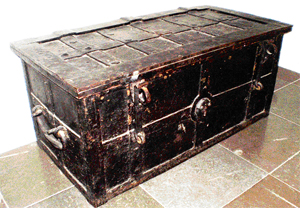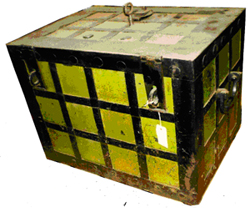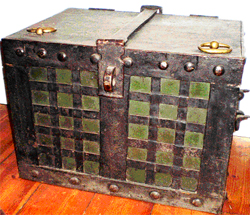A need arose in the nineteenth century for safe storage chests for valuables for various reasons, such as the rapid expansion of postal services and the accelerating impact of industrialization on society’s development and credit needs. Consequently, banks and the postal service had the greatest need for money chests.
Banks: a brief history
Bankers and banks have lent money in countries such as Italy since the fifteenth century. However, in the seventeenth century the foundation was laid for the contemporary banking system through the printing of banknotes and issuing of loans. For a short time in 1661, Stockholm Banco (also known as the Bank of Palmstruch) became the first bank in Europe to issue banknotes. This role was soon transferred to Riksens Ständers Bank. In 1773, Diskontkompaniet became the first bank in Sweden to accept deposits from the public and issue loans against personal guarantees. Eight such operations were active in 1818.
Sweden’s first savings bank opened in Göteborg in 1820 and in 1875 there were 325 savings banks scattered across the country. There were also a small number of commercial banks. Finland followed the Swedish pattern and Helsingfors Sparbank (Helsinki Savings Bank) opened in 1826, with the provision that “Security is guaranteed by storing all funds and documents in a money chest with two different locks. Different members of the administration have the keys in rotating order, one key per member.” Thus the members of the administration personally accepted all risk.
Everything of value was saved in money chests.
Banks and post offices transported money on armed horse-drawn stagecoaches, which had a space on board adapted for chests.
The post office: a brief history
 Postal services began in Sweden in the early seventeenth century with postmen riding on horseback. In 1636 the postal service was created, which became Postverket in 1685 when postmarks were introduced. Six years later, the first nationwide charge for postage was applied. During the first years of the eighteenth century an attempt was made at a stagecoach run to carry the mail from Stockholm to Hamburg. In 1850 Postverket became Kungliga Generalpoststyrelsen and the horse-drawn mail stagecoaches became common, though they would soon have competition from postal transports by rail. That same year there were 302 post offices in Sweden to handle 7 million pieces of mail. In 1885, 35 years later, 88 million pieces of mail were delivered and the number of post offices had increased to more than 1,600. At this time even women were employed at the post offices.
Postal services began in Sweden in the early seventeenth century with postmen riding on horseback. In 1636 the postal service was created, which became Postverket in 1685 when postmarks were introduced. Six years later, the first nationwide charge for postage was applied. During the first years of the eighteenth century an attempt was made at a stagecoach run to carry the mail from Stockholm to Hamburg. In 1850 Postverket became Kungliga Generalpoststyrelsen and the horse-drawn mail stagecoaches became common, though they would soon have competition from postal transports by rail. That same year there were 302 post offices in Sweden to handle 7 million pieces of mail. In 1885, 35 years later, 88 million pieces of mail were delivered and the number of post offices had increased to more than 1,600. At this time even women were employed at the post offices.
Throughout this long period, all post offices handled vast quantities of cash and each office owned at least one money chest, which was usually firmly screwed down into the wood floor.
Others in society who handled cash and securities
Others who had money chests included private wealthy individuals, such as owners of mines, steel mills and lumber operations. Within industry and workshops they were found in the finance department, as well as in churches, shipping lines and at the county administrative boards’ tax collectors.
In Sweden imported safes did not begin to compete until the middle of the nineteenth century. Imported safes were extremely expensive before domestic production began.
 |
| Still at the County Administrative Board in Jönköping: money chest of sheet iron with false keyhole on front. No lock on the lid; the chest was only locked with two padlocks. Photo by the author. |
 |
 |
| Money chest, Göteborg City Museum. |
Photo by the author. |